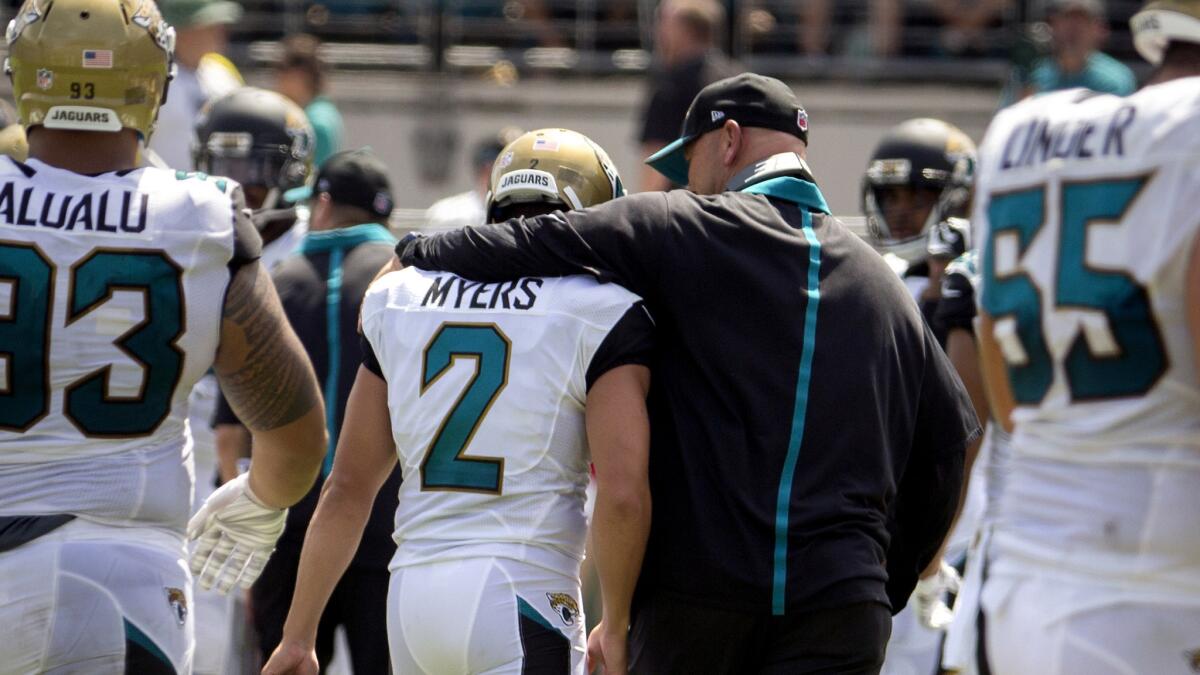Column: It doesn’t take long for longer extra points to make impact in NFL

Jacksonville Jaguars Coach Gus Bradley talks to kicker Jason Myers after he missed an extra point during the first half of their 20-9 loss to the Carolina Panthers on Sunday.
- Share via
Thirteen yards backward. One big step forward.
The ceremonial extra-point kick is history, and one week into the NFL season, the new rules are having an impact.
There were four botched PATs in the first weekend of games — three were off target and one was blocked — meaning the league is already halfway to its number of misses for the entire 2014 season.
By a 30-2 vote in the off-season, teams decided to do away with the most predictable play in sports, one with a 99% success rate, and move the line of scrimmage on PATs from the two back to the 15. That makes for a 33-yard kick. While that still falls within the comfort range of NFL kickers, it’s unquestionably more challenging than a 19-yarder.
In Week 1, kickers made 71 of 75 extra-point attempts (94.7%). While that’s significantly better than, say, the best team free-throw percentage in the NBA last season — the Portland Trail Blazers made 80.1% of their foul shots — PATs are no longer “gimmes.”
“A 33-yarder is a kick that you are supposed to make, but obviously you can miss it,” said former NFL kicker Michael Husted, now a coach for kickers at all levels. “If you notice, not everyone’s lining up in the middle like you would on a traditional extra point. You see guys lining up on the left hash to kick it. Dan Bailey [of the Dallas Cowboys] lines up on the right hash when he kicks his. That’s when you know there’s a thought process there.”
Houston’s Randy Bullock had the dubious distinction Sunday of being the first kicker to miss one of the new XL extra points, but Jacksonville’s Jason Myers and San Diego’s Josh Lambo soon followed suit. A PAT by Cincinnati’s Mike Nugent was blocked.
“Honestly, I thought I hit it pretty well,” Bullock told reporters the day after the game, a 27-20 loss to Kansas City. “It just tailed off more than anything. That’s the impact of the new rule. It’s not a routine play.”
Because of consecutive penalties, Cleveland’s Travis Coons was left in the unenviable position of having to kick a 48-yard extra point, which he made with ease.
According to STATS research, the NFL has averaged 10.2 missed extra-point kicks per season during the past decade. Last year, kickers went 1,222 for 1,230 (99.3%) on PATs.
Betting expert R.J. Bell said he expects the longer kicks to affect point spreads.
“Making the extra point longer will result in more missed extra points and likely more two-point attempts, which in combination will result in less uniform scoring this NFL season,” Bell, founder and chief executive of Pregame.com, said in an email.
“Less uniform scoring means less games with the historically most common margins of victory — such as 3, 7, and 10. As a result, professional bettors are valuing these point spreads less than in years past.”
In making the extra-point kicks longer, the NFL was also hoping to lure more teams to attempt a two-point conversion from the two-yard line. It’s difficult to gauge how much of an enticement that was in the first weekend, because each of the five two-point attempts came in logical situations for teams to try those conversions under the old rules, too.
But the longer extra points add a bit of intrigue — or at least some breath-holding — to a play that had become an academic exercise.
“At the end of the day, kickers are sort of being penalized for being good,” said Husted, founder of HustedKicking.com. “But they were looking to spice things up, and this is a way to do it. There will be a couple of games that will be determined specifically by a missed PAT, that’s for sure.”
And the storm clouds could be gathering.
“Let’s see what happens when the weather starts getting colder, and the wind starts picking up,” Husted said. “When you’re kicking from that distance, there’s a deep, dark underlying, ‘Hey, I can miss this thing.’”
Twitter: @LATimesfarmer
More to Read
Go beyond the scoreboard
Get the latest on L.A.'s teams in the daily Sports Report newsletter.
You may occasionally receive promotional content from the Los Angeles Times.











